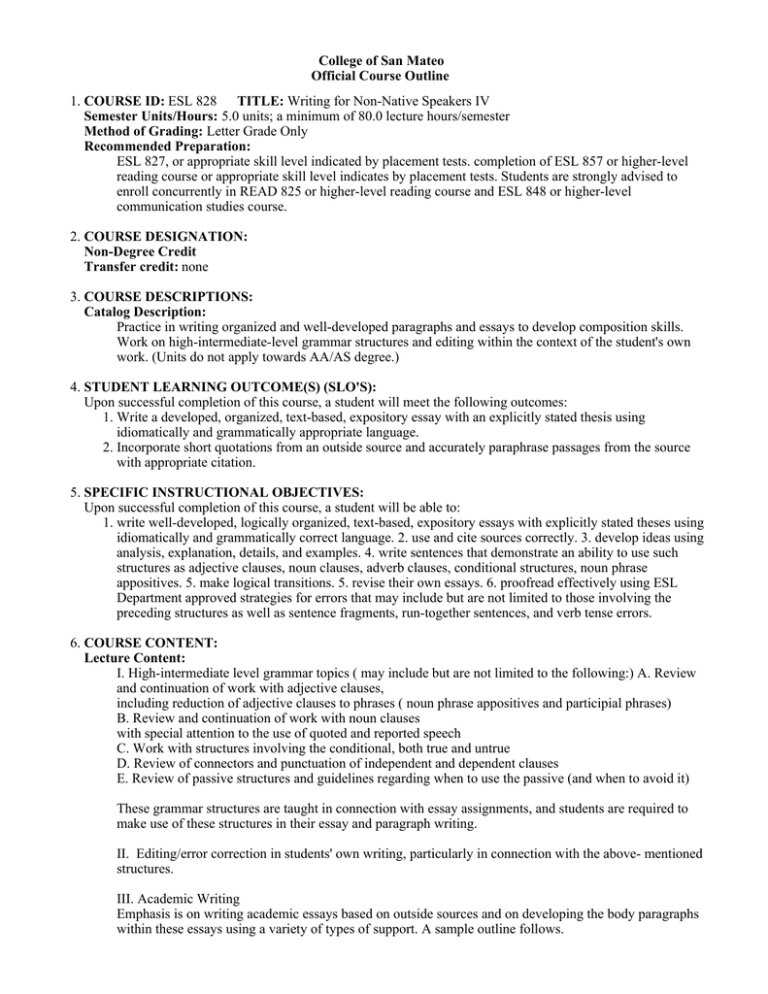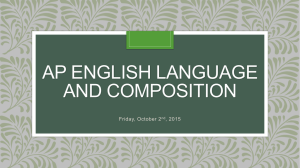College of San Mateo Official Course Outline COURSE ID: Semester Units/Hours:
advertisement

College of San Mateo Official Course Outline 1. COURSE ID: ESL 828 TITLE: Writing for Non-Native Speakers IV Semester Units/Hours: 5.0 units; a minimum of 80.0 lecture hours/semester Method of Grading: Letter Grade Only Recommended Preparation: ESL 827, or appropriate skill level indicated by placement tests. completion of ESL 857 or higher-level reading course or appropriate skill level indicates by placement tests. Students are strongly advised to enroll concurrently in READ 825 or higher-level reading course and ESL 848 or higher-level communication studies course. 2. COURSE DESIGNATION: Non-Degree Credit Transfer credit: none 3. COURSE DESCRIPTIONS: Catalog Description: Practice in writing organized and well-developed paragraphs and essays to develop composition skills. Work on high-intermediate-level grammar structures and editing within the context of the student's own work. (Units do not apply towards AA/AS degree.) 4. STUDENT LEARNING OUTCOME(S) (SLO'S): Upon successful completion of this course, a student will meet the following outcomes: 1. Write a developed, organized, text-based, expository essay with an explicitly stated thesis using idiomatically and grammatically appropriate language. 2. Incorporate short quotations from an outside source and accurately paraphrase passages from the source with appropriate citation. 5. SPECIFIC INSTRUCTIONAL OBJECTIVES: Upon successful completion of this course, a student will be able to: 1. write well-developed, logically organized, text-based, expository essays with explicitly stated theses using idiomatically and grammatically correct language. 2. use and cite sources correctly. 3. develop ideas using analysis, explanation, details, and examples. 4. write sentences that demonstrate an ability to use such structures as adjective clauses, noun clauses, adverb clauses, conditional structures, noun phrase appositives. 5. make logical transitions. 5. revise their own essays. 6. proofread effectively using ESL Department approved strategies for errors that may include but are not limited to those involving the preceding structures as well as sentence fragments, run-together sentences, and verb tense errors. 6. COURSE CONTENT: Lecture Content: I. High-intermediate level grammar topics ( may include but are not limited to the following:) A. Review and continuation of work with adjective clauses, including reduction of adjective clauses to phrases ( noun phrase appositives and participial phrases) B. Review and continuation of work with noun clauses with special attention to the use of quoted and reported speech C. Work with structures involving the conditional, both true and untrue D. Review of connectors and punctuation of independent and dependent clauses E. Review of passive structures and guidelines regarding when to use the passive (and when to avoid it) These grammar structures are taught in connection with essay assignments, and students are required to make use of these structures in their essay and paragraph writing. II. Editing/error correction in students' own writing, particularly in connection with the above- mentioned structures. III. Academic Writing Emphasis is on writing academic essays based on outside sources and on developing the body paragraphs within these essays using a variety of types of support. A sample outline follows. A. Unit One 1. Components of the writing process 2. The organization of the essay 3. Review of paragraph organization 4. Discussion of related reading 5. Discussion of appropriate and inappropriate use of sources 6. Editing and proofreading practice Essay Assignment #1 ( a minimum of 300 words; will generally involve reference to and analysis of one outside source, such as a newspaper article, a textbook chapter, a film, a picture or a song.) Students are expected to • write an expository essay consisting of an introduction, thesis, body and conclusion; • clearly distinguish between the students' own words and the words of the original author; • develop ideas using explanation, details, and examples. B. Unit Two 1. Continued work with essay organization a. Focus on connection between thesis statement and topic sentences b. Practice with one type of introductory paragraph 2. Continued work on paragraph development a. Using support from texts to explain topic sentence b. Arranging support effectively c. Order of importance 3. Discussion of use of quotation versus paraphrase 4. Discussion of plagiarism: appropriate and inappropriate use of outside sources 5. Discussion of one outside source, such as a text, an illustration, a work of art, a video 6. Editing and proofreading practice Essay Assignment #2 ( a minimum of 500 words; will generally involve reference to and analysis of at least one outside source, such as a newspaper article, a textbook chapter, a film, a picture or a song, or evidence from more than one chapter from a full-length book) Students are expected to • write an expository essay consisting of an introduction, thesis, body and conclusion; • clearly distinguish between the students' own words and the words of the original author; • develop ideas using examples from the source and explanation of the meaning of these examples. C. Unit Three 1. Refinement of work on the essay a. Practice with additional types of introductory paragraphs b. Work on writing the concluding paragraph 2. Discussion of two or more sources 3. Use of support from more than one source to develop a topic 4. Continued practice with quotation and paraphrase 5. Editing and proofreading practice Essay Assignment #3 (500-750 words; will generally involve reference to and analysis of at least two outside sources, such as newspaper articles, works of art, essays) Students are expected to • write an expository essay consisting of an introduction, thesis, body and conclusion; • clearly distinguish between the students' own words and the words of the original author; • develop topic sentences from observations based on close analysis of the sources; • present and thoroughly analyze evidence from the sources to support topic sentences. D. Unit Four 1. Additional practice with skills addressed in Unit Three 2. Discussion of several texts 3. Practice with the use of support from several outside sources 4. Continued practice with quotation and paraphrase 5. Editing and proofreading practice Essay Assignment #4 (500-750 words; will generally involve reference to and analysis of at least three outside sources, such as newspaper articles, works of art, essays) Students are expected to • write an expository essay consisting of an introduction, thesis, body and conclusion; • clearly distinguish between the students' own words and the words of the original author; • develop topic sentences from observations based on close analysis of the sources; • present and thoroughly analyze evidence from the sources to support topic sentences. Lab Content: ESL 828 does not have a lab component. TBA Hours Content: ESL 828 does not have a TBA component. 7. REPRESENTATIVE METHODS OF INSTRUCTION: Typical methods of instruction may include: 1. Lecture 2. Directed Study 3. Activity 4. Critique 5. Discussion 6. Other (Specify): 1. Using inductive methods to elicit students' prior experience with and knowledge of a topic to be dealt with in a writing assignment; 2. Using student-centered activities that enable students to • discover what they already know about a topic: • help each other to decipher the meaning of a document or artifact: • serve as supportive but appropriately helpful readers of each others' essays. 3. Using lectures along with demonstrations of grammtical structures: 4. Using inductive methods to elicit students' prior knowledge of the target grammar structure and to encourage them to generate rules based on examples provided: 5. Using reading materials to build schema for writing assignments; 6. Using reading materials--both published and student generated--to focus on rhetorial structures as well as exemplary sentences; 7. Using sentence combining to help students develop syntactical sophistication; 8. Using journal assignments written both inside and outside of class to help students develop fluency in writing; 9. Using error logs or similar record-keeping tables to encourage students to be accountable for correcting their own grammatical errors before submitting work to be graded; 10. Conducting in-class editing workshops to help students to identify their own errors. 11. Using Peer Review sheets to help students develop the ability to help their classmates improve as writers and to help them develop an awareness of audience. 8. REPRESENTATIVE ASSIGNMENTS Representative assignments in this course may include, but are not limited to the following: Writing Assignments: Four Out-of-class Essays with multiple drafts Reading Journals Two in-class Essays In-class Final Exam See attachments: Reading Assignments: Short articles from newspapers, magazines, or journals A complete novel, memoir, or piece of non-fiction See attachments: 9. REPRESENTATIVE METHODS OF EVALUATION Representative methods of evaluation may include: 1. Class Participation 2. Class Work 3. Exams/Tests 4. Home Work 5. Papers 6. Quizzes 7. Written examination 8. A possible formula for determing course grades is as follows: (1.) Four Essays written outside of class: 40% (2.) Two Essays written in class: 10% (3.) Reading Quizzes: 10% (4.) Grammar Quizzes: 10% (5.) Homework: 5% (6.) Final Exam (Essay written in class): 25% 10. REPRESENTATIVE TEXT(S): Possible textbooks include: 1. Azar, B.. Understanding and Using English Grammar, 4 ed. White Palins: Pearson Education, 2009 2. Sampson, D., Jenkins, G., Hunt, R.. The Pact, ed. New York: Riverhead Books, 2002 3. Oshima, A., Hogue, A.. Writing Academic English, 4 ed. White Plains: Pearson Longman, 2006 4. Hickam, H.. October Sky, ed. New York: Dell, 1999 Origination Date: August 2010 Curriculum Committee Approval Date: November 2012 Effective Term: Fall 2013 Course Originator: Brandon Smith /body




